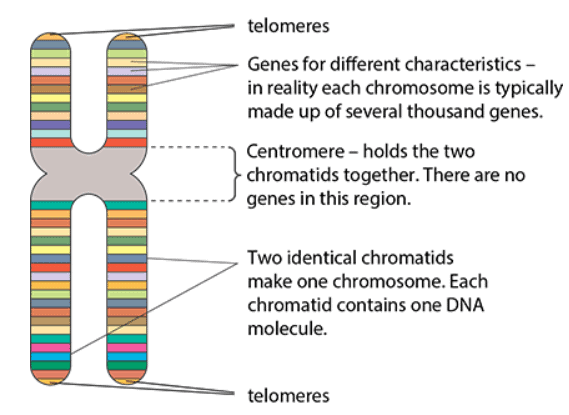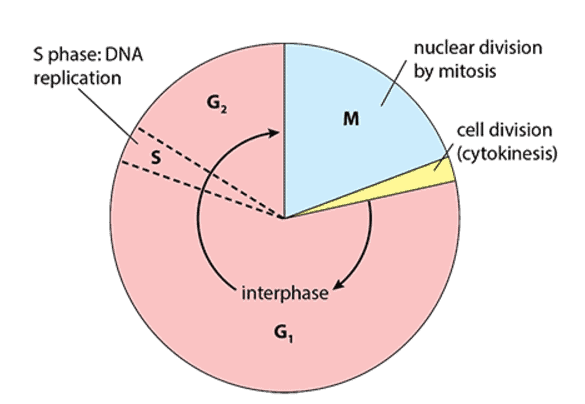AS Level Biology 9700
5. The mitotic cell cycle
Written by: Pranav I
Formatted by: Pranav I
Formatted by: Pranav I
Index
5.1 Growth and reproduction
- All cells (except gametes) in the bodies of multicellular organisms are genetically identical → all came from the zygote
- Cells reproduce by dividing and passing on copes of their genes to daughter cells
- All cells (except gametes) in the bodies of multicellular organisms are genetically identical → all came from the zygote
- Cells reproduce by dividing and passing on copes of their genes to daughter cells
5.2 Chromosomes
- Sister chromatids → two identical chromatids of one chromosome held together by the centromere (position is characteristic for specific chromosomes)
- Formed during interphase by the replication of the DNA strand
- The genes on the chromatids are identical
- Made of chromatin - a combination of DNA and proteins
- Histones - DNA winds around the outside of these proteins; basic in nature (easily interact with acidic DNA)
- Sister chromatids → two identical chromatids of one chromosome held together by the centromere (position is characteristic for specific chromosomes)
- Formed during interphase by the replication of the DNA strand
- The genes on the chromatids are identical
- Made of chromatin - a combination of DNA and proteins
- Histones - DNA winds around the outside of these proteins; basic in nature (easily interact with acidic DNA)

5.3 The cell cycle
- It is the sequence of events that takes place from one cell division until the next; it is made up of interphase, mitosis (nuclear division) and cytokinesis (cell division)
-
Interphase
-
G1 phase
- The gap after cell division and before S phase Cells make RNA, enzymes and other proteins needed for growth
-
G1 phase
-
S phase
- Signal may be received that the cell should divide again
- DNA in the nucleus replicates so that each chromosome consists of two identical chromatids
- Relatively short phase
- The centrosome replicates to form two centrosomes
- Construction of kinetochores begins
-
G2 phase
- Cell continues to grow
- New DNA made during the S phase is checked (errors are usually repaired)
- Preparations are made for division
- Eg: Sharp increase in tubulin production to make microtubules for the mitotic spindle
- Growth stops temporarily
- Nucleus divides into two identical nuclei
- Animal cells - constriction/infolding of cytoplasm between the two new nuclei
- Plants cells - formation of a new cell wall (cell plate) between the two new nuclei

5.4 Mitosis
- Nuclear division that produces two genetically identical daughter nuclei, each containing the same number of chromosomes as the parent nucleus
-
Prophase
- Chromosomes start to appear as the chromatin coils up (early prophase)
- Nuclear envelope breaks up into small vesicles (disassembles)
- Nucleolus forms part of several chromosomes (disappears)
- Chromosomes are seen to contain two identical chromatids
- Centrosomes move to the opposite ends of nucleus to form the poles of the spindle
-
Metaphase
- Centrosomes reach the poles (to organize the production of spindle microtubules)
- Chromosomes line up across the equator of the spindle
- Attached to the spindle by their centromeres
-
Anaphase
- Chromatids move to opposite poles (centromeres first; pulled by the spindle)
-
Telophase
- Chromatids reach the poles of the spindle and begin to recoil
- Nuclear envelope and nucleolus begin to re-form
- Remains of spindle is broken down
- Plants cells do not contain centrosomes
- New cell wall forms between daughter nuclei after mitosis
- Nuclear division that produces two genetically identical daughter nuclei, each containing the same number of chromosomes as the parent nucleus
-
Prophase
- Chromosomes start to appear as the chromatin coils up (early prophase)
- Nuclear envelope breaks up into small vesicles (disassembles)
- Nucleolus forms part of several chromosomes (disappears)
- Chromosomes are seen to contain two identical chromatids
- Centrosomes move to the opposite ends of nucleus to form the poles of the spindle
-
Metaphase
- Centrosomes reach the poles (to organize the production of spindle microtubules)
- Chromosomes line up across the equator of the spindle
- Attached to the spindle by their centromeres
-
Anaphase
- Chromatids move to opposite poles (centromeres first; pulled by the spindle)
-
Telophase
- Chromatids reach the poles of the spindle and begin to recoil
- Nuclear envelope and nucleolus begin to re-form
- Remains of spindle is broken down
- Plants cells do not contain centrosomes
- New cell wall forms between daughter nuclei after mitosis
Centrosomes, centrioles and centromeres
- Each centrosome consists of a pair of centrioles surrounded by proteins
- Centromeres are the site of attachment of spindle microtubules
- Two kinetochores (protein) are present at the centromere, one on each chromatid
- The pulling action is achieved by the shortening of the microtubules, both from the pole and the kinetochores
- Each centrosome consists of a pair of centrioles surrounded by proteins
- Centromeres are the site of attachment of spindle microtubules
- Two kinetochores (protein) are present at the centromere, one on each chromatid
- The pulling action is achieved by the shortening of the microtubules, both from the pole and the kinetochores
The importance of mitosis
-
Growth of multicellular organisms
- Cloning of cells via mitosis allows for multicellular organisms to grow from unicellular zygotes
- Replacement of damaged or dead cells
- Repair of tissues by cell replacement
-
Asexual reproduction
- Offsprings are genetically identical to the parents
- Budding is used for multicellular organisms
-
Immune response
- The cloning of B and T lymphocytes is dependent on mitosis
-
Growth of multicellular organisms
- Cloning of cells via mitosis allows for multicellular organisms to grow from unicellular zygotes
- Replacement of damaged or dead cells
- Repair of tissues by cell replacement
-
Asexual reproduction
- Offsprings are genetically identical to the parents
- Budding is used for multicellular organisms
-
Immune response
- The cloning of B and T lymphocytes is dependent on mitosis
5.5 The role of telomeres
- A short part of the DNA is not copied during replication → this information is lost → loss of vital genes results in cell death
- Telomeres contain short repeated sequences of DNA (multiple repeat sequences)
- Gradually get shorter as the cells replicate and age
- Make DNA a bit longer and have no useful information
- Extra bases are added to telomeres after each cell cycle to prevent loss from non-telomere DNA (telomerase enzyme)
- Telomerase does not add bases to telomeres in specialized cells
5.6 The role of stem cells
- Relatively unspecialized cells that retains the ability to divide an unlimited number of times, and which have the potential to become specialized cells
- Totipotent, pluripotent and multipotent based on their potency (ability to different cell types)
- The more specialized the cell, the lower its ability to divide (most cells in human adults do not divide)
- Stem cells are present in the skin, bone marrow, gut and heart for growth and repair
5.7 Cancers
- A result of uncontrolled mitosis → cancerous cells divide repeatedly to form a tumor (an irregular mass of cells)
- Mutations in genes that control division result in oncogenes
- Carcinogen is a substance or environmental factor that can cause cancer
- Malignant tumors spread from their site of origin; benign tumors do not
- Metastasis is the breaking off of cells from malignant tumors and spreading to other parts of the body
